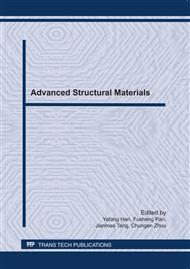p.140
p.146
p.151
p.157
p.162
p.168
p.176
p.181
p.186
High Strain Rate Compression Behavior and Constitutive Relation of As-Extruded Mg-Gd-Y Magnesium Alloy
Abstract:
The high strain rate compression behavior of extruded Mg-Gd-Y magnesium alloy was tested by split Hopkinson pressure bar (SHPB) under the strain rates of 465s-1,2140s-1 and 3767s-1. As comparison the quasi-static compression behavior was tested in the meanwhile. The results show that the quasi-static yield stress is equivalent to that of high strain rates, but the flow stress at high strain rates are higher than that of quasi-static stain rate at the same strain. When the strain rate is increase from quasi-static to high strain rates the deformation stresses increase obviously but within the present testing high strain rates, increasing the strain rate the stress has a slight increasing, indicating that at high strain rate the stress of Mg-Gd-Y magnesium alloy is not sensitive to the strain rate. The constitutive equation between deformation stress, strain and strain rate was build based on the tested compression stress strain curves. The calculated stress strain data were compared with tested stress strain curves. The results demonstrate that when the strain rates are 0.001s-1,465s-1,2140s-1 respectively the calculated and experimental data are fit very well. The calculated stress is higher than that of tested stress if the strain rate is increase to 3767s-1 and the strain is more than 0.15. The discrepancy was explained through the physical soundness of Johnson-Cook model.
Info:
Periodical:
Pages:
162-167
Citation:
Online since:
June 2011
Authors:
Price:
Сopyright:
© 2011 Trans Tech Publications Ltd. All Rights Reserved
Share:
Citation:


